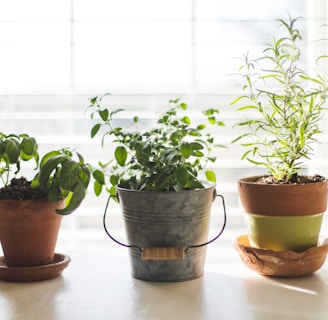Indoor Plants for Better Health
Debbie
3/18/20242 min read


Outer Ecosystem fuels the Inner Ecosystem
Many people dream of having a lush garden filled with beautiful flowers and fresh vegetables, but not everyone has access to a spacious outdoor area. Luckily, you can still enjoy the benefits of gardening by starting a garden inside your house. In this article, we will explore the advantages of indoor gardening and how you can get started.
1. Year-Round Gardening
One of the biggest advantages of indoor gardening is that it allows you to grow plants all year round. Unlike traditional outdoor gardens that are limited by seasonal changes and weather conditions, indoor gardens provide a controlled environment where plants can thrive regardless of the time of year. This means you can enjoy fresh herbs, microgreens, and vegetables even during the winter months.
2. Easy Transplantation
Starting your plants indoors allows you to grow microgreens and vegetable starter plants that are easy to transplant to an outdoor garden when the time is right. By starting your plants indoors, you can give them a head start and ensure they are strong and healthy before moving them outside. This increases their chances of survival and allows them to establish themselves more quickly in the garden.
3. Improved Air Quality
Indoor plants not only add beauty to your home but also improve the air quality. They act as natural air purifiers by absorbing carbon dioxide and releasing oxygen. Additionally, plants can help remove toxins from the air, making it cleaner and healthier for you and your family to breathe. By starting a garden inside your house, you can create a more pleasant and refreshing living environment.
When starting an indoor garden, there are a few key factors to consider:
Lighting:
Plants need sufficient light to grow, so make sure to place them near a window where they can receive adequate sunlight. If natural light is limited, you can also use artificial grow lights to supplement the lighting needs of your plants.
Watering:
Proper watering is essential for the health of your indoor garden. Be sure to water your plants regularly, but avoid overwatering as it can lead to root rot. It's a good idea to check the moisture level of the soil before watering to ensure you are providing the right amount of water.
Choosing the Right Plants:
Not all plants are suitable for indoor gardening. When selecting plants for your indoor garden, consider their light and temperature requirements, as well as their size and growth habits. Some popular choices for indoor gardening include herbs like basil and mint, leafy greens such as lettuce and spinach, and compact vegetables like cherry tomatoes and peppers.
Starting a garden inside your house is a rewarding and fulfilling endeavor. It allows you to enjoy the benefits of gardening regardless of the space limitations or weather conditions. So why not give it a try and bring the joy of gardening indoors?
